Poodle
.jpg) Standard Poodle. Simple pet clip | |
| Other names |
|
|---|---|
| Origin |
(disputed - see history) |
| Domestic dog (Canis lupus familiaris) | |
| Classification and standards | ||
|---|---|---|
| AKC | Standard: Non-sporting Miniature: Non-sporting Toy: Toy |
Standard, miniature, and toy |
| ANKC | Group 7 (Non-sporting) | Standard Miniature Toy |
| CKC | Standard: Group 9 – Sporting Miniature: Group 9 – Sporting Toy: Group 5 – Toys |
Standard miniature toy |
| FCI | Group 9 Section 2 Poodle #172 |
Standard, medium, miniature, toy |
| KC (UK) | Utility | Standard Miniature Toy |
| NZKC | Non-sporting | Standard Miniature Toy |
| UKC | Standard: Gun Dogs Miniature: Companion Dogs Toy: Companion Dogs |
Standard, miniature, and toy |
The poodle is a group of formal dog breeds, the Standard Poodle, Miniature Poodle and Toy Poodle. The origin of the breed is still discussed, with a prominent dispute over whether the poodle descends from Germany as a type of water dog, or from the French Barbet.[5]
Ranked second most intelligent dog breed just behind the Border Collie,[6] the poodle is skillful in many dog sports and activities, including agility, obedience, tracking to herding, circus performers or assistance dogs. Poodles have taken top honors in many conformation shows, including "Best in Show" at the Westminster Kennel Club Dog Show in 1991 and 2002, and at the World Dog Show in 2007 and 2010.
Toy Poodles won "Best in Show" at Crufts in 1966 and 1982. Standard Poodles achieved the award in 1955, 1985, 2002, and 2014. The 2002 winner came from Norway and was the first overseas exhibit to win the Crufts best in show award.[7][8][9]
History

The European mainland had known the poodle long before it was brought to England. Drawings by German artist Albrecht Dürer established the popular image of the breed in the 15th and 16th centuries. It was the principal pet dog of the late 18th century in Spain, as shown by the paintings of the Spanish artist Francisco Goya. France had toy poodles as pampered favorites during the reign of Louis XVI at about the same period.[10]
The Fédération Cynologique Internationale, the international ogranization of which both France and Germany's main kennel clubs are members, claims the breed descends from the French Barbet.[1] When the breed was officially recognized by the FCI, in order to avoid any possible dispute between two founding members, Germany recognized the Poodle as a dog originating from France.[11] The progenitor of the breed might have also been crossed with the Hungarian Puli.[12] The French name Caniche comes from the word cane (the female of the duck) since this type of breed was used as a water retriever mainly for duck hunting thanks to its swimming ability.[13]
The British Kennel Club states that the breed originates in Germany,[3] as do the American Kennel Club and the Canadian Kennel Club, stating: "Despite the Poodle’s association with France, the breed originated as a duck hunter in Germany..."[4] The Oxford English Dictionary and the American Heritage Dictionary both trace the etymology of Poodle to the German Pudel, which itself comes from Pudelhund. The word Pudel in turn comes from Low German pud(d)eln meaning "[to] splash in water,"[14][15] cognate with the English word puddle.
The poodle has contributed to many other dog breeds, such as the Miniature Schnauzer,[16] Standard Schnauzer,[17] and dogs of the Bichon type[18] in order to either save those breeds from extinction, reduce size, or by dog fanciers to improve their appearance.
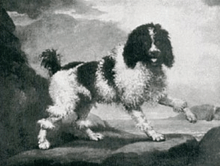
Size variants
The poodle has been bred in at least three sizes, including Standard, Miniature, and Toy. According to the American Kennel Club, which recognized the breed in 1887,[19] the Standard Poodle is the oldest of the three varieties,[20] and was later bred down to the miniature and toy sizes. The British Kennel Club also recognizes three sizes, stating that the miniature and toy are scaled down versions of the standard.[21] The Fédération Cynologique Internationale (FCI) recognizes four sizes of one breed: standard, medium, miniature, and toy. Poodles exist in many coat colours. Despite the Standard Poodle's claim to greater age than the other varieties, some evidence shows the smaller types developed only a short time after the breed assumed the general type by which it is recognized today.
The smallest, or Toy variety, was developed in England in the 18th century. Hunting and working dogs were typically of the standard variety, though some reports suggest that smaller varieties such as the miniature may have been popular for truffle hunting, as their feet were less likely to damage the delicate fungi.[22] Miniature and Toy varieties tend to be bred primarily for companionship. In the mid to late 19th century, the trade in dyeing and affixing their fur to unusual proportions began with the need to compliment the Victorian and Georgian sensibilities of these women,[23] to the point that their status as a dog of the middle and upper classes was quite solid by the time of the founding of the Kennel Club in the 1870s as they were one of the first dog breeds registered.
Work and sport
Traditionally the Standard Poodle, the largest of the breed, was a retriever or gun dog, used in particular for duck hunting and sometimes upland bird hunting. The breed has been used for fowl hunting in US and Canada since the early 1990s, in and out of hunting tests. The modern Standard retains many of the traits prized by their original owners: a keen working intelligence that makes the dog easy to command, webbed feet that make it an agile swimmer (all of the poodle's ancestors and descendants had or share the love of water) athletic stamina, and a moisture-resistant, curly coat that acts like a wool jumper in damp conditions. Towards the second half of the nineteenth century their use in hunting declined in favour of their use in circuses and status symbols of the wealthy, so that by the 20th century they were only found as companions or circus dogs.[24] However, in the past 20 years, some breeders in the United States and Canada have been selecting for dogs with drive for birds in order to revive the breed for hunting, with some success.[25] The Canadian Kennel Club admitted the Standard Poodle for hunting trials in 1996 and the American Kennel Club in 1998, respectively.[26]
As of May 2017, the end results of 25 years of breeding to reawaken the hunting instinct have been a success. It has resulted in dogs that are very eager to please their masters. It has resulted in a gun dog with extreme intelligence, a relentless drive to catch its quarry, and strong swimming skills that requires special training: their aptitude is second only to the British Border Collie[6] and thus the hunting Standard Poodle requires the gunman to be quite specific as to what he wants and how he wants it done. Unlike other spaniels and retrievers, Standard Poodles will attempt to solve a problem independently and need to be told specifically what is wanted when tracking and retrieving a bird. Because they are highly intelligent, harsh or violent training methods do not work with this dog breed in the field—corrections must be timely and given with precision, and the trainer must have a firm but kind hand; an overbearing owner training his dog to hunt will find his Standard poodle terrified of his master and the entire experience, and refusing to budge an inch towards the water or into the brush.[27]

Hunting poodles typically are dogs with lightning quick reflexes, sprinting hard on command after the downed bird and having a prodigious ability to remember where the bird fell and (though not as good as the English Pointer) a decent nose to sniff and track a bird hiding in tall grass[28][29] Recently, Miniature Poodles have also begun to be added to the list of hunters in the field: in January 2002, the Canadian Kennel Club opened their Working Certificate program to poodles of all sizes and later in 2014 the American Kennel club opened their Hunt Test program to miniature poodles; in 2017 both the Standard and Miniature were declared eligible for American Kennel Club Spaniel Tests, a program designed for testing dogs with flushing capabilities.[30][31][32] Typically, a Miniature Poodle will be the smallest dog of all in the field as it weighs less than 25 lbs or about 10 kg: this is even less than a Boykin Spaniel, the former smallest dog, which weighs closer to 35 lbs, or 16 kg. However, hunters in the USA and Canada have found them very useful for woodcock, chukar, mallards, and smaller ducks like the green-winged teal and bufflehead: their tiny size is an asset in getting at corners and brush that comparatively more massive retrievers cannot reach or where bramble is too thick for cocker spaniels to access.[33][34]
Poodles have been used as working dogs in the military since at least the 17th century. During WWII, Roland Kilbon of the New York Sun, reported that other countries had used dogs in their armies for many years. In his column he quoted Mrs. Milton S. (Arlene) Erlanger, owner of Pillicoc Kennels, a premier breeder of Poodles "The dog must play a game in this thing." Eventually, "With the blessing of the American Kennel Club, the Professional Handlers Association, obedience training clubs across the country, and Seeing Eye, Inc., a nationwide program known as Dogs for Defense, Inc. was initiated and became the official procurement agency for all war dogs used in the Army, Navy and Coast Guard."[35] Dogs for Defense procured the dogs who were then trained by the Army. In 1942, the Poodle was one of 32 breeds officially classified as war dogs by the Army.
In competition
Standard Poodles have been winning titles against the more widely used native breeds like the Chesapeake Bay Retriever, Nova Scotia Duck Tolling Retriever, American Water Spaniel and Labrador Retriever.[36] Thus far 13 Standard Poodles have won Master Hunt titles (12 in the United States, 1 in Canada) and several more have won senior and junior titles on both sides of the border. Currently only the United Kennel Club in the US recognizes the Standard Poodle as a Sporting dog, thus in spite of this subtype of poodle being ineligible for field competitions more and more are appearing in the field as waterfowl dogs and hunters of pheasant in tall grass, the latter especially in the Midwest.[37]
Description
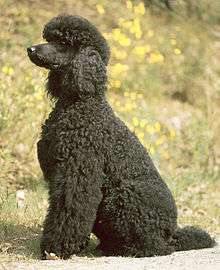
Appearance
The poodle is an active, intelligent and elegant dog, squarely built, and well proportioned. To ensure the desirable squarely built appearance, the length of body measured from the breastbone to the point of the rump approximates the height from the highest point of the shoulders to the ground. The eyes should be very dark, oval in shape, and have an alert and intelligent expression. The ears should fold over close to the head, set at, or slightly below, eye level. The coat should be of naturally curly texture, dense throughout, although most AKC-registered show dogs have a lion-cut or other, similarly shaven look. The sizes of the official AKC-recognized Poodle breeds are determined by height, not by weight.
Poodles are bred in a variety of sizes, distinguished by adult shoulder (withers) height. The exact height cutoffs among the varieties vary slightly from country to country. The Fédération Cynologique Internationale (FCI) recognizes four sizes of one breed: standard, medium, miniature, and toy.[38] Non-FCI kennel clubs generally recognize three sizes, standard, miniature, and toy, sometimes as sizes of the same breed and sometimes as separate breeds. Only the FCI describes a maximum size for Standard Poodles. France is the country responsible for the breed in the FCI, and in this country, the puppies of all sizes are listed together.[39] The terms royal standard, teacup, and tiny teacup are marketing names, and are not recognized by any major kennel club.
| Size | The Kennel Club (UK) | Australian National Kennel Council | New Zealand Kennel Club | Canadian Kennel Club | American Kennel Club | United Kennel Club | Fédération Cynologique Internationale |
|---|---|---|---|---|---|---|---|
| Standard, Grand | over 38 cm (15 in) | 38 cm (15 in) and over | 38 cm (15 in) and over | over 38 cm (15 in) | over 38 cm (15 in) | over 38 cm (15 in) | 45–60 cm (18–24 in) |
| Medium, Moyen | not used | not used | not used | not used | not used | not used | 35–45 cm (14–18 in) |
| Miniature - Dwarf, Nain | 28–38 cm (11–15 in) | 28–38 cm (11–15 in) | 28–38 cm (11–15 in) | 10–15 in (25–38 cm) | 10–15 in (25–38 cm) | 10–15 in (25–38 cm) | 28–35 cm (11–14 in) |
| Toy | under 28 cm (11 in) | under 28 cm (11 in) | under 28 cm (11 in) | under 10 in (25 cm) | under 10 in (25 cm) | under 10 in (25 cm) | 24–28 cm (9.4–11.0 in) |
All the Fédération Cynologique Internationale Poodles are in Group 9 Companion and Toy, Section 2 Poodle. All the Kennel Club poodles are in the Utility Group. All three sizes of poodles for the Australian National Kennel Council and the New Zealand Kennel Club are in the Non-sporting Group. The Canadian Kennel Club and the American Kennel Club place standard and miniature sizes in the Non-sporting Group, and the toy size in the Toy Group. The United Kennel Club places the miniature and toy in the Companion Group and the standard poodle in the Gundog Group.
Coat
Unlike most dogs which have double coats, poodles have a single layer coat (no undercoat is present) composed of dense, curly fur[41] that sheds minimally.[42] They could be considered hypoallergenic (though not completely allergen free).[43][44] The poodle does shed, but instead of the fur coming off the dog, it becomes tangled in the surrounding hair. This can lead to matting without proper care. Texture ranges from coarse and woolly to soft and wavy. Poodle show clips require many hours of brushing and care per week, about 10 hours/week for a Standard Poodle. Poodles are usually clipped down into lower-maintenance cuts as soon as their show careers are over. Pet clips are much less elaborate than show and require much less maintenance. A pet owner can anticipate grooming a poodle every six to eight weeks.
Clips
Generally, the owners clip their dogs as they want; however, if they want their dogs in conformation shows, a show clip is a requirement. Many breed registries allow only certain clips for poodles shown in conformation. In American Kennel Club (AKC) shows, adults must be shown in the "Continental" or "English saddle" clips. Dogs under 12 months old may be shown with a "puppy clip". The AKC allows the "Sporting" clip in Stud Dog and Brood Bitch classes, as well.
Some sources believe the show clips evolved from working clips, which originally provided warmth to major joints when the dogs were immersed in cold water. The rest of the body is shaved for less drag in the water. Others express skepticism at this theory, instead citing the French circus as the origin of the entertaining and unique clips.
The second puppy clip is also called the Scandinavian clip or puppy clip. It was invented by Swedish and Norwegian show groomers in the 1970s. It is the most common one in all sizes for shows in Europe, and is allowed for adult poodles to be shown in the FCI countries. The face, throat, belly, feet and the base of the tail are shaved five to seven days before the show to get a nice, smooth appearance of the shaved areas. The hair on the head is left to form a "topknot", fixed in place using latex bands, because in most European countries, hair spray is banned. The rest of the dog is shaped with scissors.
In the continental clip, the face, throat, feet and part of the tail are shaved. The upper half of the front legs is shaved, leaving "fluffy pompons" around the ankles. The hindquarters are shaved except for pompons on the lower leg (from the hock to the base of the foot) and optional round areas (sometimes called "rosettes") over the hips. The continental clip is the most popular show clip today.
The English saddle clip is similar to the continental, except for the hindquarters, which are not shaved except for a small, curved area on each flank (just behind the body), the feet, and bands just below the stifle (knee) and above the hock, leaving four (4) pompons. This clip is now rarely seen in standard poodles.
Pet clips can be as simple or as elaborate as owners wish. The hair under the tail should always be kept short to keep feces from matting in the dog's curls. Most owners also keep the feet and face clipped short to prevent dirt from matting between toes, tear stains on lighter-coated poodles and food from matting around the dog's muzzle. Beyond these sanitary requirements, desired clips depend on owners' preferences. Some owners maintain a longer clip in winter than summer.
Corded coat
In most cases, whether a poodle is in a pet or show clip, the hair is completely brushed out. Poodle hair can also be "corded" with rope-like mats similar to those of a Komondor or human dreadlocks. Though once as common as the curly poodle, corded poodles are now rare. Corded coats are difficult to keep clean and take a long time to dry after washing. Any poodle with a normal coat can be corded when its adult coat is in. Corded poodles may be shown in all major kennel club shows.[1][45][46]
- Different clips
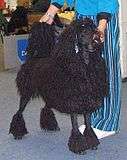 Corded Standard Poodle
Corded Standard Poodle- Toy Poodle Scandinavian clip
 11-month-old white Standard Poodle modern clip
11-month-old white Standard Poodle modern clip- White Standard Poodle Scandinavian clip, tail not docked
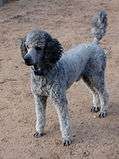 Silver male Standard Poodle pet clip.
Silver male Standard Poodle pet clip.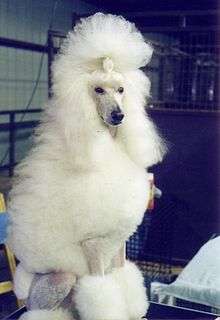 White Standard Poodle Continental clip
White Standard Poodle Continental clip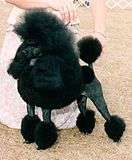 Black Miniature Poodle Continental clip
Black Miniature Poodle Continental clip- Poodle Scandinavian clip
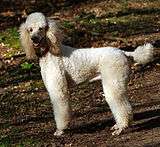 Cream Standard Poodle Lamb clip with high-shaved feet
Cream Standard Poodle Lamb clip with high-shaved feet Toy Poodle
Toy Poodle
Colours
The Poodle has a wide variety of colouring, including white, black, brown, parti, silver, gray, silver beige, apricot, red, cream, sable, and patterns such as phantom and brindle. The AKC recognizes Poodles in either solid-coloured or particoloured coats.[47] Recognition of particolour (spotted) Poodles varies by registry. Phantom, brindle, and sable are considered out of standard by all major registries. Recognized FCI colourations are black, white, brown, gray, apricot, and red.
For solid-coloured poodles, the coat is an even and solid colour at the skin. In blues, grays, silvers, browns, cafe-au-laits, apricots and creams, the coat may show varying shades of the same colour. This is frequently present in the somewhat darker feathering of the ears and in the tipping of the ruff. While clear colours are preferred by registries, such natural variation in the shading of the coat is not to be considered a fault. Brown and cafe-au-lait poodles have liver-coloured noses, eye rims and lips, dark toenails and dark amber eyes. Black, blue, gray, silver, cream and white poodles have black noses, eye rims and lips, black or self-coloured toenails and very dark eyes. In the apricots, while the foregoing colouring is preferred, liver-coloured noses, eye rims and lips, and amber eyes are permitted, but are not desirable. Incomplete colour of nose, lips and eye rims, or a "mismatched" colour are considered faults by registries.
Parti-coloured poodles are recognized in poodle history as the original colouring of the poodle.[48] A parti poodle has solid-coloured patches over a white coat. The coat will usually be white and coloured in equal amounts, though it can vary with a larger percent of white. Registries prefer that parti poodles have the same points as its correlating solid-coloured descendants. Brown and white parti poodles have liver-coloured noses, eye rims and lips, dark or self-coloured toenails and amber eyes. This is also permitted, but not preferred, in apricot and white parti poodles. Black/white, Blue/white, and silver/white poodles have black noses, eye rims and lips, black or self-coloured toenails and very dark eyes. When the dog has markings that resemble those of a tuxedo, it is called a "tuxedo" poodle. The upper coat is solid: head, back, tail; and the lower coat is white: neck, chest, abdomen, and legs, making up usually 40% or more of the coat.
Phantom poodles have the colouring of a Doberman Pinscher, with a lighter colour appearing on their "eyebrows", muzzle and throat, legs and feet and below their tail. Like Dobermans, phantom poodles have either a black or brown main coat with a tan (usually apricot or red) lighter colourings around the eyebrows, muzzle, throat, legs, feet, and below their tail.
 White Poodles
White Poodles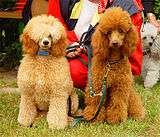 Apricot and red Poodles
Apricot and red Poodles.jpg) Black Poodle
Black Poodle- Toy Poodle aged 16 still has an active life
 Brown Standard Poodle at five weeks
Brown Standard Poodle at five weeks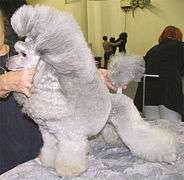 Mature grey Poodle
Mature grey Poodle Phantom Poodles
Phantom Poodles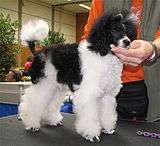 Miniature Harlequin Poodle
Miniature Harlequin Poodle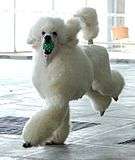 Standard Poodle catching a ball
Standard Poodle catching a ball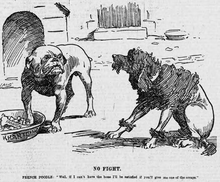 1898 political cartoon: Great Britain as the English Bulldog; France as the French Poodle
1898 political cartoon: Great Britain as the English Bulldog; France as the French Poodle
Temperament
Poodles are known as a highly intelligent, energetic, and sociable breed. They require both physical and intellectual activities. Of note is this breed's keen sense for instinctive behavior. In particular, marking and hunting drives are more readily observable in poodles than in most other breeds. A typical poodle should be reserved with strangers upon first introduction, but after a while should slowly reveal a warm and personable disposition. Snappy, vicious behavior is considered a serious fault in the breed.[49]
Poodles are highly trainable dogs that typically excel in obedience training. A poodle will do well at many dog sports, including dog agility,[50] flyball,[51][52] dock diving,[53] field tracking, and even schutzhund,[54] and can follow owners on hiking trips or any trip involving swimming,[55] as long as the dog is accustomed to water and swimming.
Of the size varieties, Standard Poodles are the most highly recommended for families with children. They have a kindly demeanor and a love of playing games. As with all dogs and babies, introductions should be gradual, though most Standards will tolerate a baby and learn to be gentle and will respect toddlers so long as the child is supervised.[56] A Standard Poodle will be fine in a family with many children provided the environment is stable, orderly, and relaxed, with enough room for the dog to go out and retire to if needed.[57][58] Miniature and Toy varieties tend to have less patience with young children and might find certain children's antics too much to handle, especially because young children are much larger than they are and may attempt to grab them without understanding how their attempt to hug the pooch is terrifying to a small dog. They are likely to bite out of fear and thus are better suited to homes with teenagers or older children.[59] Poodles dislike being left alone or left out of the family fun and some get anxious at being left in the house alone, but sign of nervousness or neurosis is atypical and not how a poodle of any size is meant to behave.
Health
The most common serious health issues of Standard Poodles listed in order of the number of reported cases in the Poodle Health Registry (20 August 2007) are Addison's disease, gastric dilatation volvulus, thyroid issues (hyperthyroid and hypothyroid), tracheal collapse, epilepsy, sebaceous adenitis, juvenile renal disease, hip dysplasia, and cancer. Standard Poodles are also susceptible to some health issues usually too minor to report to the health registry. The most common of these minor issues is probably ear infection. Ear infections are a problem in all poodle varieties because their nonshedding coat grows into the ear canal, where it traps wax and dirt. Ear problems can be minimized by proper ear care, including regular cleaning and plucking of hair within the ear canal. A veterinarian should be consulted if the dog shows signs of an ear infection.
Standard Poodles in UK, Denmark and USA/Canada surveys had a median lifespan of 11.5 to 12 years.[60] In a UK survey, the most common causes of death were cancer (30%), old age (18%), GDV (6%), and cardiac disease (5%).[61]
Miniature and Toy Poodles in UK surveys had median lifespans of 14 to 14.5 years.[60] In Miniatures, the leading cause of death was old age (39%).[61] In Toys, the leading causes of death were old age (25%), and kidney failure (20%).[61]
Addison's disease
Addison's disease is (as of 20 August 2007) the illness most commonly reported to the Poodle Health Registry. The number of reported cases is nearly twice as high as the next most common problem (GDV). Addison's disease is characterized by insufficient production of glucocorticoid and/or mineralocortoid in the adrenal cortex (near the kidneys). Addison's is often undiagnosed because early symptoms are vague and easily mistaken for other conditions. Standard Poodles with unexplained lethargy, frequent gastric disturbances, or an inability to tolerate stress should be tested for it. Addison's can cause fatal sodium/potassium imbalances, but if caught early and treated with lifelong medication, most dogs can live a relatively normal life.
Gastric dilatation volvulus
There is a high incidence of gastric dilatation volvulus (GDV) in this breed, which occurs when twisting of the stomach (volvulus or torsion) causes or is caused by excess gas. Symptoms include restlessness, inability to get comfortable, pacing, or retching without being able to bring up anything. The dog's abdomen may be visibly swollen, but bloat or torsion can occur without visible swelling. A dog with GDV requires immediate veterinary care. The dog's survival usually depends on whether the owner can get to a veterinarian in time. GDV risk is increased with faster eating and a raised feeding bowl.[62]
Reproduction
| Size | Average litter size at birth | Range | Stillborn (%) | Early neonatal mortality (%) |
|---|---|---|---|---|
| Standard | 7.0 | 2–12 | 2.5 | 1.7 |
| Medium | 3.7 | 1–10 | 1.8 | 3.6 |
| Miniature | 3.0 | 1–8 | 2.5 | 2.5 |
| Toy | 2.4 | 1–4 | 2.5 | 3.0 |
Breed size is correlated with litter size and Standard Poodles have the highest litter size followed by Medium, Miniature, and Toy. Toy Poodles have one of the smallest litter size of all breeds.[63] The stillborn rate and early neonatal mortality (death within 1 week from birth) in poodles are lower than the average across all breeds.[64]
Poodle crossbreeds
Poodles are crossed with other breeds for various reasons, and the resulting puppies (called designer dogs) are described by whimsical portmanteau words, such as cockapoo or spoodle (Cocker Spaniel), maltipoo (Maltese), goldendoodle (Golden Retriever), labradoodle (Labrador), Schnoodle (Schnauzer), Pekapoos (Pekingese), Cavapoo (Cavalier King Charles), Bernedoodle (Bernese Mountain Dog) and many others.
A cross between a shedding breed and a poodle (which does not shed much) does not reliably produce a nonshedding dog. Traits of puppies from crossbreedings are not as predictable as those from purebred poodle breedings, and the crosses may shed or have unexpected or undesirable qualities from the parent breeds.
Poodle crossbreds (also called hybrids) are not recognized by any major breed registry, as crossbreds are not one breed of dog, but two. If both parents are registered purebreds but of different breeds, it is still not possible to register a puppy as two different breeds. Some minor registries and Internet registry businesses will register dogs as any breed the owner chooses with minimal or no documentation; some even allow the breeder or owner to make up a new "breed name".
Hypoallergenic qualities
Poodles are often cited as a hypoallergenic dog breed. Their individual hair follicles have an active growth period that is longer than that of many other breeds of dogs; combined with the tightly curled coat, which slows the loss of dander and dead hair by trapping it in the curls, an individual poodle may release less dander and hair into the environment. In addition, most poodles are frequently brushed and bathed to keep them looking their best; this not only removes hair and dander, but also controls the other potent allergen, saliva.[65]
Although hair, dander, and saliva can be minimized, they are still present and can stick to "clothes and the carpets and furnishings in your home"; inhaling them, or being licked by the dog, can trigger a reaction in a sensitive person. An air cleaner, air duct outlet and vacuuming with a vacuum cleaner with a HEPA filter can help clear dander floating in the air.[66]
The word hypoallergenic, when referring to a dog, is also a misconception; all dogs shed. Poodles shed hair in minimal amounts, and also release dander, but are not as likely to trigger allergies as much as many other breeds. Additionally, poodle maintenance must include some amount of regular shaving, which releases hair dust in the air.
Cultural visibility
Poodles are commonly known as extensively groomed show dogs and companions with a distinctive clip, to such a degree that poodles in short pet clips often go unrecognized or mistaken as Poodle crosses ("Doodles"). This association of the breed's appearance and the resulting preconceptions is strong, and reflects in popular culture, where poodles most often are depicted as spoiled and perhaps obnoxious pets, or if anthropomorphic, snobby, selfish, and vain. Poodle owners are perceived stereotypically as fussy, frivolous, and impractical.
Notes
Note 1. ^ Fur is defined by the Oxford English Dictionary as "the short, soft hair of certain animals"[67] whereas hair is defined as "any of the fine thread-like strands growing from the skin of mammals and other animals, or from the epidermis of a plant."[68]
References
- 1 2 3 "Archived copy" (PDF). Archived (PDF) from the original on 8 May 2015. Retrieved 10 December 2014. , Fédération Cynologique Internationale: Poodle Breed Standard. Retrieved 5 August 2016
- ↑ "Archived copy". Archived from the original on 15 January 2018. Retrieved 15 January 2018. , La Centrale Canine: Poodle Breed Standard. Retrieved 15 January 2018
- 1 2 "Breed Information Centre Poodle (Standard)". KC.org.uk. The Kennel Club. Archived from the original on 10 September 2017. Retrieved 15 January 2018.
The Poodle originates in Germany, where it was bred as a water retriever, used by duck hunters.
- 1 2 "Poodle History & Training". AKC.org. American Kennel Club. Archived from the original on 8 January 2018. Retrieved 15 January 2018.
Despite the Poodle’s association with France, the breed originated as a duck hunter in Germany
- ↑
- "Breed Information Centre Poodle (Standard)". KC.org.uk. The Kennel Club. Archived from the original on 10 September 2017. Retrieved 15 January 2018.
The Poodle originates in Germany, where it was bred as a water retriever, used by duck hunters.
- "Poodle History & Training". AKC.org. American Kennel Club. Archived from the original on 8 January 2018. Retrieved 15 January 2018.
Despite the Poodle’s association with France, the breed originated as a duck hunter in Germany
- "Poodle (breed of dog)". Britannica.oom. Encyclopædia Britannica, Inc. Archived from the original on 15 January 2018. Retrieved 15 January 2018.
- "Poodle". Encyclopedia.com. Columbia University Press, Inc. Archived from the original on 15 January 2018. Retrieved 15 January 2018.
- "Fédération Cynologique Internationale: Poodle Breed Standard" (PDF). Archived (PDF) from the original on 3 March 2016. Retrieved 5 August 2016.
- "La Centrale Canine: Poodle Breed Standard". Archived from the original on 15 January 2018. Retrieved 15 January 2018.
- "Breed Information Centre Poodle (Standard)". KC.org.uk. The Kennel Club. Archived from the original on 10 September 2017. Retrieved 15 January 2018.
- 1 2 "THE INTELLIGENCE OF DOGS". Stanleycoren.com. Archived from the original on 13 January 2015. Retrieved 11 December 2014.
- ↑ Dogworld: Digital Crufts Edition (2010): p. 87
- ↑ Dogworld: Digital Crufts Edition (2010): p. 84
- ↑ "Norwegian poodle wins Crufts". BBC News. 10 March 2002. Archived from the original on 17 April 2004. Retrieved 28 December 2009.
- ↑ "American Kennel Club - Poodle History". Akc.org. Archived from the original on 25 January 2010. Retrieved 18 January 2010.
- ↑ "Deutscher Pudel-Klub, Rasseportrait". Deutscher-pudel-klub.de. Retrieved 15 January 2018.
- ↑ Cuvier, Georges (1827). The Animal Kingdom Arranged in Conformity with Its Organization. London: William Clowes and Sons. ISBN 978-1108049580.
- ↑ "From American Kennel Club site". Akc.org. Archived from the original on 7 August 2016. Retrieved 9 August 2016.
- ↑ "Poodle". American Heritage Dictionary. Houghton Mifflin Harcourt. Archived from the original on 9 May 2018. Retrieved 3 April 2018.
[German Pudel, short for Pudelhund : Low German pudeln, to splash about (from pudel, puddle) + German Hund, dog.]
- ↑ "Definition of poodle in English". Oxford English Dictionary. Oxford University Press. Archived from the original on 3 April 2018. Retrieved 3 April 2018.
Early 19th century: from German Pudel(hund), from Low German pud(d)eln ‘splash in water’ (the poodle being a water-dog).
- ↑ "Miniature Schnauzer History". AKC.org. Archived from the original on 16 September 2008. Retrieved 22 August 2008.
- ↑ "A Brief History of the Standard Schnauzer". standardschnauzer.org. Archived from the original on 2 May 2016. Retrieved 22 April 2016.
- ↑ "History of the Bichon Frise". Bichon Frise Club of America, Inc. Archived from the original on 13 April 2016. Retrieved 22 April 2016.
- ↑ "Poodle". American Kennel Club. Archived from the original on 20 February 2017. Retrieved 7 February 2017.
- ↑ "From American Kennel Club site". Akc.org. Archived from the original on 8 December 2014. Retrieved 11 December 2014.
- ↑ "Breed Information Centre Poodle (Standard)". KC.org.uk. The Kennel Club. Archived from the original on 10 September 2017. Retrieved 15 January 2018.
- ↑ "Poodle - Detail". American Kennel Club. Archived from the original on 7 August 2016. Retrieved 9 August 2016.
- ↑ "The genesis of the poodle hairdo". Slate Magazine. Archived from the original on 11 December 2014. Retrieved 11 December 2014.
- ↑ "Circus bygone". Poodlehistory.org. Archived from the original on 26 March 2015. Retrieved 11 December 2014.
- ↑ "Poodles ready to hunt". Denverpost.com. Archived from the original on 11 December 2014. Retrieved 11 December 2014.
- ↑ Chris Robinson. "The Ultimate Foo-Foo Returns To Its Historic Roots". Fleetfiretimbers.com. Archived from the original on 14 July 2014. Retrieved 11 December 2014.
- ↑ "Archived copy". Archived from the original on 22 December 2015. Retrieved 10 December 2015.
- ↑ "Woodie at Madison.mpg". YouTube. Archived from the original on 1 January 2015. Retrieved 11 December 2014.
- ↑ Archived 19 September 2013 at the Wayback Machine.
- ↑ "Eligible Breeds: Retriever Hunting Tests". akc.org. Archived from the original on 15 October 2017.
- ↑ "Archived copy". Archived from the original on 4 February 2017. Retrieved 15 May 2017.
- ↑ "Diminutive Hunting Poodles". Archived from the original on 19 October 2017.
- ↑ "Best In Show Daily". www.bestinshowdaily.com. Archived from the original on 14 May 2017.
- ↑ "Hunting". www.jibandsuzicope.com. Archived from the original on 19 October 2017.
- ↑ Carter Isaacson, Suzanne. "Poodles in WWII". Poodle History Project. Archived from the original on 30 December 2012. Retrieved 5 February 2013.
- ↑ Elaine Bloom; Colleen Kimble. "New York hunters discover some unusual gundog breeds" (PDF). Dec.ny.gov. Archived (PDF) from the original on 23 September 2015. Retrieved 11 December 2014.
- ↑ "That dog hunts? Yes, poodles can make good hunting dogs, too". Startribune.com. Archived from the original on 17 March 2015. Retrieved 11 December 2014.
- ↑ "Fédération Cynologique Internationale Group 9, Section 2, Poodle". Fci.be. Archived from the original on 14 March 2008. Retrieved 18 January 2010.
- ↑ "List of poodle puppies registered to the French Kennel Club". scc.asso.fr. Retrieved 18 February 2006.
- ↑ Fédération Cynologique Internationale breed nomenclature Archived 11 September 2008 at the Wayback Machine.
- The Kennel Club Dog Groups Archived 24 August 2008 at the Wayback Machine.
- Australian National Kennel Council breeds by group Archived 21 October 2007 at the Wayback Machine.
- New Zealand Kennel Club Groups
- Canadian Kennel Club breeds and Groups Archived 23 May 2013 at the Wayback Machine.
- American Kennel Club complete breed list Archived 12 November 2006 at the Wayback Machine.
- ↑ "What is the difference between hair and fur?". Scientific American. Sciam.com. 20 February 2001. Retrieved 18 January 2010.
- ↑ "Canine Lymphoma". Marvistavet.com. Archived from the original on 29 April 2011. Retrieved 21 April 2011.
Most breeds have hairs in all different stages of the growth-shed cycle at the same time. A few breeds [incl. poodle] have all hairs in the same stage of growth-shed at the same time.
- ↑ Allergic to Dogs, Is Any Dog Safe? Allergy site from an MD. Poodles, airedales, and schnauzers are cited as dogs that only shed their skin every 21 days, and so may be less of a problem for allergic people.
- ↑ Grady, Denise (5 February 1997). "Nonallergenic Dog? Not Really". The New York Times. Archived from the original on 30 January 2009. Retrieved 21 April 2011. How hypoallergenic the dog is may vary with the individual dog and the individual person.
- ↑ "American Kennel Club: Poodle Breed Standard. Retrieved May 12, 2007". Akc.org. Archived from the original on 13 January 2010. Retrieved 18 January 2010.
- ↑ "United Kennel Club: Standard Poodle Breed Standard. Retrieved May 12, 2007". Archived from the original on 11 November 2006.
- ↑ "American Kennel Club - Poodle". Akc.org. Archived from the original on 18 August 2012. Retrieved 23 August 2012.
- ↑ "Poodle History Project". Poodlehistory.org. Archived from the original on 16 August 2012. Retrieved 23 August 2012.
- ↑ "Toy Poodles, Breeds from Pet Health 101". Pethealth101.com. Archived from the original on 16 December 2014. Retrieved 11 December 2014.
- ↑ "Versatility In Poodles - Agility Poodles". Vipoodle.org. Archived from the original on 16 July 2014. Retrieved 11 December 2014.
- ↑ "North American Flyball Association - 2013 In the Spotlight". Flyball.org. Archived from the original on 12 November 2014. Retrieved 11 December 2014.
- ↑ "Laredo - Fast Fourward Flyball Team - San Diego, CA". Flyball.com. Archived from the original on 26 July 2014. Retrieved 11 December 2014.
- ↑ Debbie. "Insanity is a Terrible Thing to Waste: Why do we Dock Dive?". Debbiewachel-artist.blogspot.com. Archived from the original on 25 December 2014. Retrieved 11 December 2014.
- ↑ "Frequently Asked Questions". Wasatch Hundesport. Archived from the original on 13 December 2014. Retrieved 11 December 2014.
- ↑ "Poodle Dogs- Poodle Dog Breed Info & Pictures - petMD". Petmd.com. Archived from the original on 16 December 2014. Retrieved 11 December 2014.
- ↑ "Poodle Dogs and Children - Poodle Savvy". Poodle Savvy. Archived from the original on 25 July 2014. Retrieved 11 December 2014.
- ↑ "Poodle (Standard) : Dog Breed Selector : Animal Planet". Animal Planet. Archived from the original on 18 February 2015. Retrieved 11 December 2014.
- ↑ "Standard Poodle - Temperament & Personality". Petwave.com. Archived from the original on 9 December 2014. Retrieved 11 December 2014.
- ↑ "Miniature Poodle Information, Pictures of Miniature Poodles - Dogster". Dogster.com. Archived from the original on 13 December 2014. Retrieved 11 December 2014.
- 1 2 Pullman.com Archived 17 July 2007 at the Wayback Machine. Dog Longevity Web Site. Compiled by K. M. Cassidy. Retrieved 28 June 2007.
- 1 2 3 Thekennelclub.org.uk Archived 4 May 2007 at the Wayback Machine., Kennel Club/British Small Animal Veterinary Association Scientific Committee. 2004. Purebred Dog Health Survey. Retrieved 28 June 2007.
- ↑ "Non-dietary risk factors for gastric dilatation-volvulus in large and giant breed dogs" (PDF). Archived (PDF) from the original on 17 February 2013. Retrieved 16 December 2012.
- 1 2 Borge, K. S.; Tønnessen, R.; Nødtvedt, A.; Indrebø, A. (2011). "Litter size at birth in purebred dogs—A retrospective study of 224 breeds". Theriogenology. 75 (5): 911–919. doi:10.1016/j.theriogenology.2010.10.034. PMID 21196028.
- 1 2 Tønnessen, R.; Borge, K. S.; Nødtvedt, A.; Indrebø, A. (2012). "Canine perinatal mortality: A cohort study of 224 breeds". Theriogenology. 77 (9): 1788–1801. doi:10.1016/j.theriogenology.2011.12.023. PMID 22365700.
- ↑ "Hair vs Fur". Dogplay.com. Archived from the original on 16 March 2010. Retrieved 18 January 2010.
- ↑ Archived 15 December 2008 at the Wayback Machine.
- ↑ Askoxford.com. "Oxford Dictionaries, Ask Oxford - fur". Askoxford.com. Retrieved 18 January 2010.
- ↑ Askoxford.com. "Oxford Dictionaries, Ask Oxford - hair". Askoxford.com. Archived from the original on 26 May 2005. Retrieved 18 January 2010.
External links
| Wikimedia Commons has media related to Poodle. |